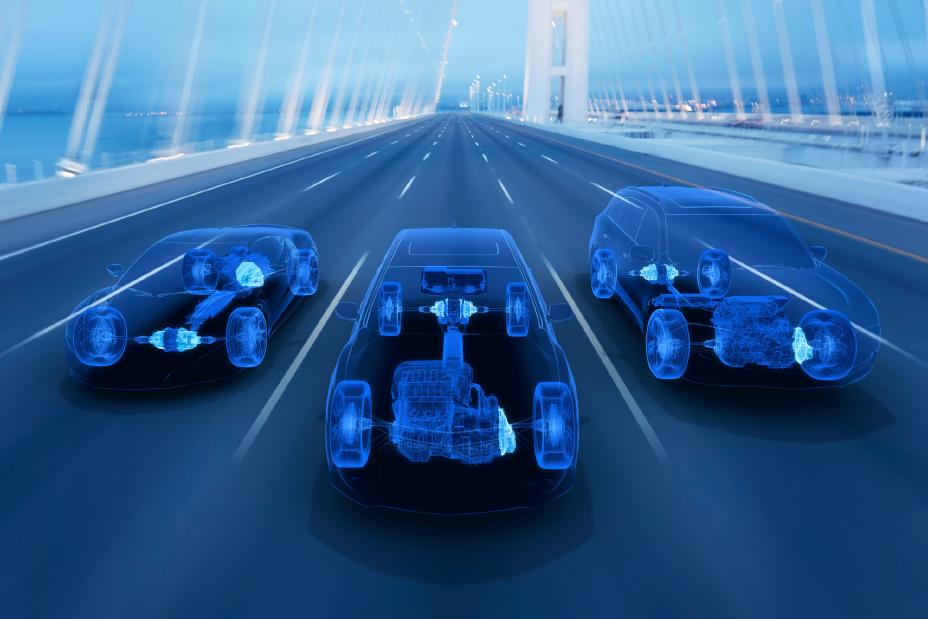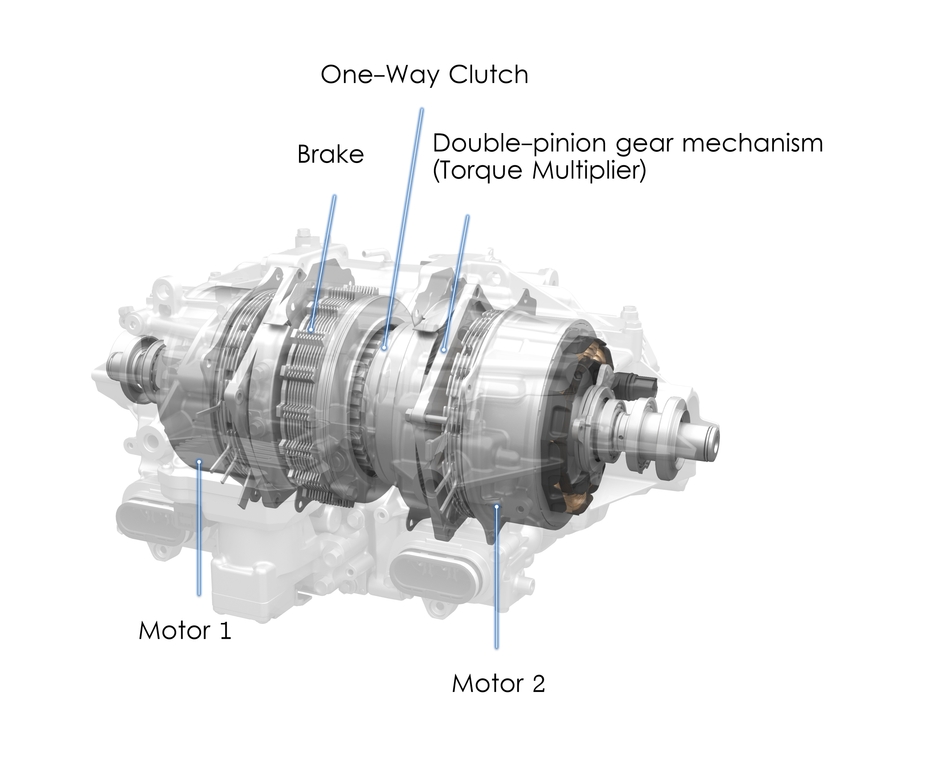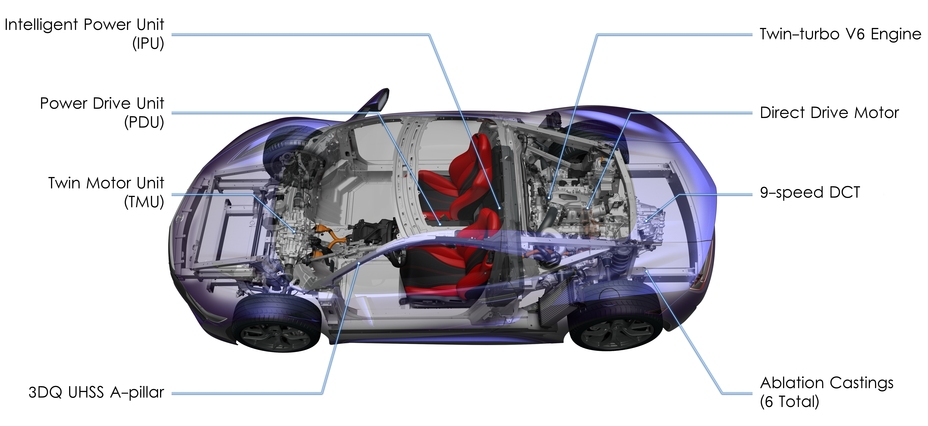- World's first all-wheel drive system to use independent electric motors for torque vectoring, introduced on the 2012 NSX Concept
- Builds on the principles of active torque vectoring first established with mechanical Super Handling All-Wheel Drive™
- Sport Hybrid technology is fundamental to the performance of the Acura NSX supercar
Fundamental to the performance of the second-generation Acura NSX, Acura's Sport Hybrid Super Handling All-Wheel Drive™ (SH-AWD®) expands on the torque vectoring capabilities of mechanical SH-AWD® to provide advanced power delivery and unique handling performance.
Designed by Acura, Sport Hybrid SH-AWD® delivers a unique combination of efficiency and performance by applying hybrid technology and using the instantaneous torque of electric motors to improve acceleration, fuel efficiency and handling.
A first-of-its-kind technology, Sport Hybrid SH-AWD® was first showcased on the NSX Concept at the North American International Auto Show (NAIAS) in 2012 and made its production debut in the U.S. on the 2014 Acura RLX Sport Hybrid. Utilizing torque generated by electric motors, Sport Hybrid SH-AWD® is radically different than Acura's mechanical SH-AWD® system. Although both systems feature torque vectoring, the layout, components and operation of Sport Hybrid SH-AWD® are unique and its performance is superior.
Sport Hybrid SH-AWD® System Layout
There are two variations of the Sport Hybrid SH-AWD® system, one with the electric motors mounted on the vehicle's rear axle and another with the electric motors on the front axle. On both the 2014-2020 RLX Sport Hybrid and 2017-2020 MDX Sport Hybrid the system's electric motors were in the back. When its electric motors moved up front on the second-generation NSX, first shown at the 2015 NAIAS, Sport Hybrid SH-AWD® reached its highest performance level yet.
From left: NSX, RLX Sport Hybrid SH-AWD®, MDX Sport Hybrid SH-AWD®
Despite the unique layouts, in both variations of Sport Hybrid SH-AWD® primary power comes from a gasoline engine paired with a dual-clutch transmission (DCT). On RLX and MDX, the transmission incorporates an electric motor, while NSX uses a Direct Drive Motor sandwiched between the engine and transaxle that acts directly on the crankshaft. On the RLX and MDX Sport Hybrid, this combination powers the front axles, while it powers the rear axle of the NSX. When needed, the electric motor provides additional power for an effortless feeling of acceleration, regenerative electricity back to the battery, and under certain circumstances, can even power the car solely on electric power, in conjunction with the electric motors in the Twin Motor Unit.
In all three applications, providing power to the other axle is the Twin Motor Unit (TMU), consisting of a pair of electric motors in a single housing. An Intelligent Power Unit (IPU) contains the lithium-ion battery to supply the TMU with electricity, along with the 12-volt DC/DC converter, electronic control units (ECUs) for the three electric motors, and other components.
NSX Twin Motor Unit (TMU)
Common to all three versions of Sport Hybrid SH-AWD®, the TMU features two 36 horsepower electric motors that receive power from the IPU. Although integrated into a single unit, the TMU's two electric motors operate independently from each other and even from the gasoline engine itself, key to the system's torque-vectoring abilities. A one-way clutch can also combine the output of the electric motors when necessary for maximum use of available traction, such as in poor weather conditions.
On RLX and MDX, with the engine and transmission powering the front axle, the TMU provides additional power, optimized traction, and torque vectoring to the rear wheels. Both used a V6 engine with a 7-speed DCT with an integrated electric motor. For the RLX, the 3.5-liter V6 and electric motors combined for a of 377 total system horsepower, while the MDX with its slightly smaller 3.0-liter V6 generated 321 total system horsepower.
NSX uses a 3.5-liter twin-turbo V6 and 9-speed DCT with its Direct Drive Motor mounted between the two, and with the TMU providing power to the front wheels. Combined output for the system was 573 when NSX was introduced, growing to 600 horsepower with the introduction of the 2022 NSX Type S.
When conditions are slippery, such as in rain or snow, the Sport Hybrid system works in harmony with Vehicle Stability Assist™ (VSA®) and traction control to maximize available traction.
|
Acura Vehicles with Sport Hybrid SH-AWD® |
|
|
Model |
Drivetrain |
|
RLX Sport Hybrid (2014-2020) |
3.5-liter V6 engine |
|
MDX Sport Hybrid (2017-2020) |
3.0-liter V6 engine |
|
NSX |
3.5-liter twin-turbo V6 engine |
|
NSX Type S |
3.5-liter twin-turbo V6 engine |
Capabilities Beyond Mechanical All-Wheel Drive
When cornering, the Sport Hybrid system reveals its full potential by using torque vectoring to create a "yaw moment."
The left and right turning motion of a vehicle is known as "yaw." In conventional cars, this motion is created almost entirely by steering input applying rotational torque to the vehicle body which is known as a "yaw moment." However, in some dynamic situations, the front wheels can become overwhelmed with the multiple tasks of steering the car, supporting a large part of the vehicle's weight, and in the case of front-wheel drive vehicles, delivering power. This can cause the front tires to lose traction, a condition known as "understeer."
By contrast, a rear-wheel drive vehicle can use the power at the rear wheels to help induce a yaw moment at the rear. Known as "oversteer," this can make a rear-wheel drive vehicle feel more nimble, but too much oversteer can make a vehicle unstable and cause a spin.
Conventional all-wheel drive systems seek a compromise between front and rear-wheel drive by routing power to the front and rear at the same time to increase stability. The downside to this is that the front wheels are still primarily responsible for inducing the yaw moment, making the car feel less nimble as a result. The fact that the steering is primarily responsible for the yaw moment are the reason traditional AWD systems typically lack the agile feel of the best two-wheel drive systems.
Mechanical SH-AWD® overcomes this by turning the outside rear wheel faster than the average speed of the two front wheels. This helps create a new yaw moment at the rear of the vehicle, relieving the front tires of some of the work of turning the car, reducing understeer to keep the vehicle balanced and controllable. In addition, with the cornering load more evenly distributed between the front and rear tires, the total available cornering grip is more fully realized.
RLX Sport Hybrid SH-AWD®
The Sport Hybrid system also creates a yaw moment using the TMU, creating a torque vectoring effect by independently controlling each electric motor and overdriving the outside wheel in a corner to enhance handling response. However, because the electric motors operate independently from the engine itself, Sport Hybrid SH-AWD® can produce a yaw effect where mechanical SH-AWD® can't, such as during small throttle applications, off throttle or at very low engine speeds.
Additionally, Sport Hybrid can further enhance the torque-vectoring effect by creating an even larger torque difference between the inside and outside wheels. The system can create negative torque through regenerative braking on the inside wheel while using the electricity generated to power the outside wheel. Sport Hybrid SH-AWD® can also continue to provide a torque-vectoring effect even when there is no throttle applied at all, maintaining stability during cornering.
|
SH-AWD® |
Sport Hybrid SH-AWD® |
|
|
NSX Supercar Performance
Because the TMU is mounted on the front axle of the NSX, Sport Hybrid SH-AWD® creates unique benefits in Acura's supercar. Like all Sport Hybrids, the NSX can operate solely under electric power, features idle stop, and offers excellent fuel economy ratings compared to non-hybrid supercars. Similar to the RLX and MDX Sport Hybrids, NSX also features the benefits of on- and off-throttle torque-vectoring unique to the Sport Hybrid system.
NSX Sport Hybrid SH-AWD® layout
Unlike its Sport Hybrid counterparts, the front-mounted TMU on NSX also directly improves steering performance. NSX uses a variable gear ratio electronic power steering, which provides more or less assist, depending on the drive mode selected—the supercar's Integrated Dynamics System includes several drive modes including Sport and Track.
The Sport Hybrid system enhances this steering response through torque vectoring. As the vehicle approaches a turn, the TMU recovers energy through regenerative braking. When the driver begins to turn-in, the TMU begins the yaw moment by enhancing regenerative braking on the inside wheel, tightening the line, and allowing the driver to apply throttle earlier in advance of the apex. At that point, the TMU works in conjunction with the supercar's rear limited-slip differential to optimize available traction, extending the yaw moment.
NSX Sport Hybrid SH-AWD® in cornering
When the driver applies more throttle exiting the corner and unwinding the steering, all Sport Hybrid components begin supplying forward acceleration, including the inside front wheel that had been generating negative torque. When the car is again pointed straight, the system applies full power to all four wheels for maximum acceleration, with the torque from the electric motors giving NSX an exceptionally responsive feel and the natural reactions of an extremely nimble sports car.
On 2022 NSX Type S, the TMU benefits from more efficient use of the IPU, making the Type S feel more responsive in all modes, expanding its electric-only capabilities when in Quiet mode, and further increasing the capabilities of this incredible supercar. For more information on the most powerful production car Acura has ever made, click here.
Sport Hybrid SH-AWD®: Another Example of Technology Leadership
With its commitment to Precision Crafted Performance, Acura has remained on the cutting edge of technology since the performance brand was established more than 35 years ago. Its Sport Hybrid SH-AWD® system, the first-ever torque-vectoring hybrid system, not only created a new category of performance drivetrains, it helped elevate the incredible performance of the brand's legendary NSX supercar.
# # #











